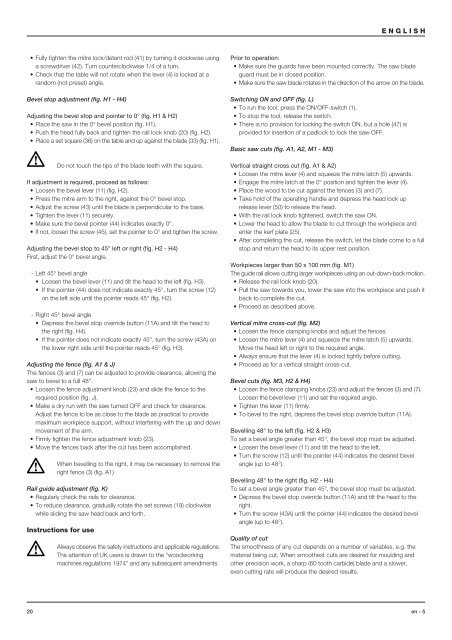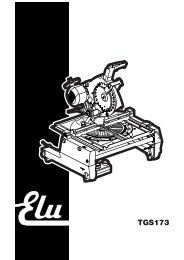Manuale istruzione - Service après vente
Manuale istruzione - Service après vente
Manuale istruzione - Service après vente
You also want an ePaper? Increase the reach of your titles
YUMPU automatically turns print PDFs into web optimized ePapers that Google loves.
ENGLISH• Fully tighten the mitre lock/detent rod (41) by turning it clockwise usinga screwdriver (42). Turn counterclockwise 1/4 of a turn.• Check that the table will not rotate when the lever (4) is locked at arandom (not preset) angle.Bevel stop adjustment (fig. H1 - H4)Adjusting the bevel stop and pointer to 0° (fig. H1 & H2)• Place the saw in the 0° bevel position (fig. H1).• Push the head fully back and tighten the rail lock knob (20) (fig. H2).• Place a set square (36) on the table and up against the blade (33) (fig. H1).Do not touch the tips of the blade teeth with the square.If adjustment is required, proceed as follows:• Loosen the bevel lever (11) (fig. H2).• Press the mitre arm to the right, against the 0° bevel stop.• Adjust the screw (43) until the blade is perpendicular to the base.• Tighten the lever (11) securely.• Make sure the bevel pointer (44) indicates exactly 0°.• If not, loosen the screw (45), set the pointer to 0° and tighten the screw.Adjusting the bevel stop to 45° left or right (fig. H2 - H4)First, adjust the 0° bevel angle.- Left 45° bevel angle• Loosen the bevel lever (11) and tilt the head to the left (fig. H3).• If the pointer (44) does not indicate exactly 45°, turn the screw (12)on the left side until the pointer reads 45° (fig. H2).- Right 45° bevel angle• Depress the bevel stop override button (11A) and tilt the head tothe right (fig. H4).• If the pointer does not indicate exactly 45°, turn the screw (43A) onthe lower right side until the pointer reads 45° (fig. H3).Adjusting the fence (fig. A1 & J)The fences (3) and (7) can be adjusted to provide clearance, allowing thesaw to bevel to a full 48°.• Loosen the fence adjustment knob (23) and slide the fence to therequired position (fig. J).• Make a dry run with the saw turned OFF and check for clearance.Adjust the fence to be as close to the blade as practical to providemaximum workpiece support, without interfering with the up and downmovement of the arm.• Firmly tighten the fence adjustment knob (23).• Move the fences back after the cut has been accomplished.When bevelling to the right, it may be necessary to remove theright fence (3) (fig. A1)Rail guide adjustment (fig. K)• Regularly check the rails for clearance.• To reduce clearance, gradually rotate the set screws (19) clockwisewhile sliding the saw head back and forth.Instructions for useAlways observe the safety instructions and applicable regulations.The attention of UK users is drawn to the “woodworkingmachines regulations 1974” and any subsequent amendments.Prior to operation:• Make sure the guards have been mounted correctly. The saw bladeguard must be in closed position.• Make sure the saw blade rotates in the direction of the arrow on the blade.Switching ON and OFF (fig. L)• To run the tool, press the ON/OFF-switch (1).• To stop the tool, release the switch.• There is no provision for locking the switch ON, but a hole (47) isprovided for insertion of a padlock to lock the saw OFF.Basic saw cuts (fig. A1, A2, M1 - M3)Vertical straight cross cut (fig. A1 & A2)• Loosen the mitre lever (4) and squeeze the mitre latch (5) upwards.• Engage the mitre latch at the 0° position and tighten the lever (4).• Place the wood to be cut against the fences (3) and (7).• Take hold of the operating handle and depress the head lock uprelease lever (50) to release the head.• With the rail lock knob tightened, switch the saw ON.• Lower the head to allow the blade to cut through the workpiece andenter the kerf plate (25).• After completing the cut, release the switch, let the blade come to a fullstop and return the head to its upper rest position.Workpieces larger than 50 x 100 mm (fig. M1)The guide rail allows cutting larger workpieces using an out-down-back motion.• Release the rail lock knob (20).• Pull the saw towards you, lower the saw into the workpiece and push itback to complete the cut.• Proceed as described above.Vertical mitre cross-cut (fig. M2)• Loosen the fence clamping knobs and adjust the fences.• Loosen the mitre lever (4) and squeeze the mitre latch (5) upwards.Move the head left or right to the required angle.• Always ensure that the lever (4) is locked tightly before cutting.• Proceed as for a vertical straight cross-cut.Bevel cuts (fig. M3, H2 & H4)• Loosen the fence clamping knobs (23) and adjust the fences (3) and (7).Loosen the bevel lever (11) and set the required angle.• Tighten the lever (11) firmly.• To bevel to the right, depress the bevel stop override button (11A).Bevelling 48° to the left (fig. H2 & H3)To set a bevel angle greater than 45°, the bevel stop must be adjusted.• Loosen the bevel lever (11) and tilt the head to the left.• Turn the screw (12) until the pointer (44) indicates the desired bevelangle (up to 48°).Bevelling 48° to the right (fig. H2 - H4)To set a bevel angle greater than 45°, the bevel stop must be adjusted.• Depress the bevel stop override button (11A) and tilt the head to theright.• Turn the screw (43A) until the pointer (44) indicates the desired bevelangle (up to 48°).Quality of cutThe smoothness of any cut depends on a number of variables, e.g. thematerial being cut. When smoothest cuts are desired for moulding andother precision work, a sharp (60 tooth carbide) blade and a slower,even cutting rate will produce the desired results.20 en - 5
















